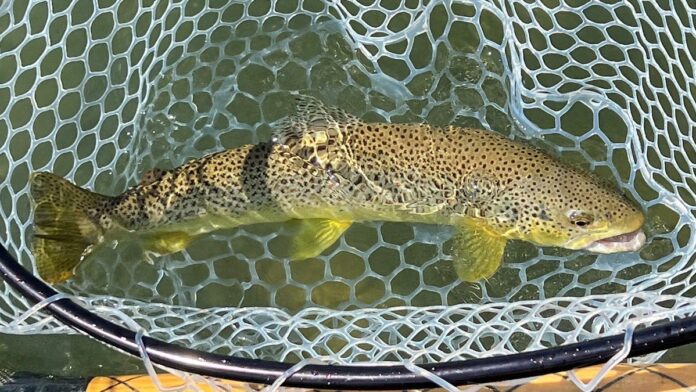I can’t recall when I first laid hands on a copy of “The Beaverkill.” When I did, I knew it was going to be difficult to put it down until I had read − and sometimes re-read − every page.
I wasn’t disappointed. I found even the bibliography and index were captivating. For me, they were more than just a road map to the stories told in the interior of the book. In combination they quantified the tremendous field work and research that it took to articulate the historical context of the book, and to provide the reader with intimate knowledge of what is often called America’s stream without ever having waded its waters.
Ed Van Put devoted 40 years of his life to the people of New York by way of his position with the Bureau of Fisheries in the New York’s Department of Environmental Conservation. He was a principal habitat/fisheries technician for 40 years.
Before he retired from his day job as a fisheries professional, he pressed the powers that be to put rules in place at DEC and the New York City Department of Environmental Protection that would assure adequate cold water releases were made and continue to be made from New York City’s Catskill Reservoirs to protect what are considered by many to be some of the best trout fisheries in the country. In large measure it was Van Put who convinced Catskill landowners to sell easements to the state to provide anglers with the access they needed to experience the region’s world class trout fishing. Their passport to the streams? Nothing more than a state fishing license.
Outdoors: Deer Search available to help hunters this season; what to know
Youth Pheasant Hunt: Volunteers make the yearly Milan event successful
Turkey talk: How learning a bird’s language can help hunters
For many decades it was Van Put’s responsibility to acquire Public Fishing Rights and Fisherman Parking Areas along selected streams, as well as to review stream disturbance applications for the regulatory authorities. His work was primarily in the Catskills on renown streams such as the Beaverkill, Willowemoc and the Delaware River. He also left his mark in Dutchess County by acquiring Public Fishing Rights on local trout streams like Wappinger Creek, Ten Mile River and others. Sometimes he worked in concert with Mid Hudson Trout Unlimited and other stakeholders to secure those rights.
During his career, Van Put has secured more public access and special regulation water for fly fishers and other stream anglers, than any other individual.
Apart from his work with DEC, Van Put partners with his wife Judy − she writes a weekly fishing column for the Sullivan County Democrat − to research his literary projects. Both are members of the state Outdoor Writers Association, and both are recipients of the New York State Council of Trout Limited’s Professional Communications Award: Judy in 2005 and Ed in 2009.
Van Put has authored several books: “The Beaverkill: The History of a River and Its People” (1996);” Trout Fishing in the Catskills” (2007), “The Beaverkill” second edition (2016) with additional text and artwork, and 25 fly patterns with ties the Beaverkill; and “The Remarkable Life of James Beecher” (2021). His wife Judy has been integral to the extensive research that went into each of those books.
On Oct. 17, when the Van Puts visit Trout Unlimited, they will give a PowerPoint presentation on Artists Who Fished the Catskills. The presentation will focus on the Hudson River School of Landscape Painters and others. Judy presents the program, and at the conclusion Ed will answer questions about the program, trout fishing in the Catskills, or any other subject regarding fishing.
As always, the public is invited to attend this and any Trout Unlimited membership meeting. They meet at the American Legion Hall, 55 Overlook Rd., in Poughkeepsie, on the third Monday of the Month, beginning at 7 p.m.
For more information about Trout Unlimited visit their website, www.midhudsontu.org
Early deer season shows promising results
Reports from around the state suggest big game hunters are taking both deer and bear with some regularity.
I took five calls the first Monday of the season, but just one this week. I man the phones for Deer Search each Monday through the end of the season. I had no calls for assistance from a Dutchess County Hunter. It’s early and the situation could turn on a dome, and it often does. We can expect to see a shift once the leaves start dropping and the temperature drops with them.
One tracker reported he went on five recovery missions that resulted in one bear and five deer being recovered for hunters.
It is all but impossible to determine if the third year of Epizootic Hemorrhagic Disease is contributing to the reduced calls in this region. Southeast New York has been the epicenter of the EHD outbreak.
Researchers have determined venison harvested from an EHD infected deer is safe to eat. However, it is advisable to take precautions when handling any deer, bear, waterfowl or other wildlife when processing the meat for the table.
If you harvest a deer of bear that you do not want, call the Hunters Helping the Hungry program here in Dutchess County by calling 914-755-9667 or 845-635-606.
Bill Conners of the Federation of Fish and Game Clubs writes on outdoors issues. Email: conners@billconners.net.
Credit: Source link































